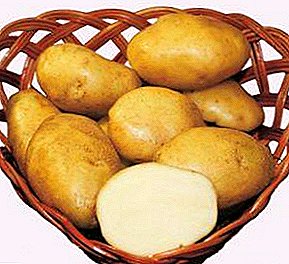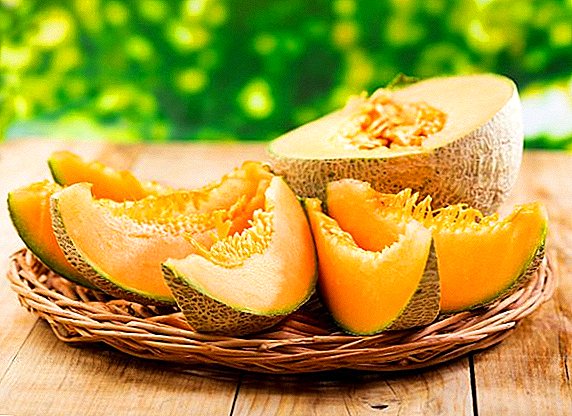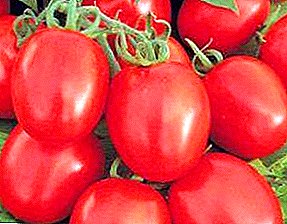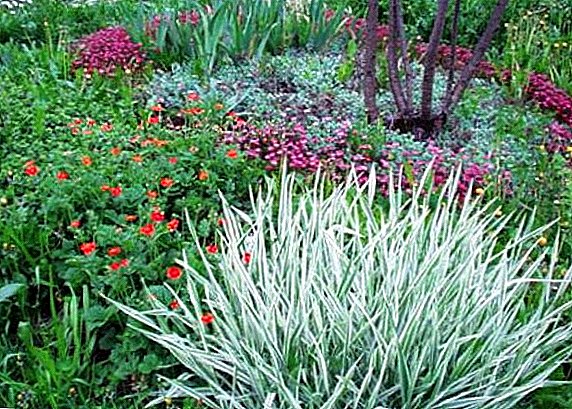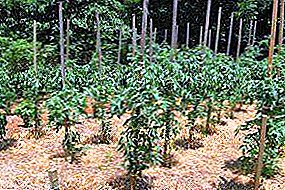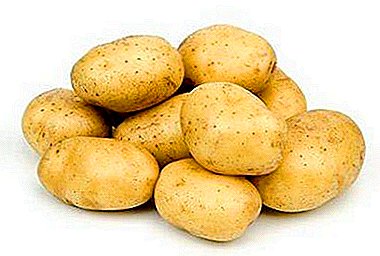
Potato "Giant" - a promising variety, guaranteeing a consistently high yield.
Tubers are large and neat, they are suitable for sale, industrial processing or personal use.
A detailed description of the variety, its agrotechnical characteristics, the subtleties of cultivation, a tendency to diseases and pest infestation - all this and a little more in our article.
Origin
Potato variety Giant bred by Russian breeders. Originator - Institute of Potato Farming. Lorch. Potatoes are brought in the State registry of the Russian Federation in 2013. Zoned for the Central, Central Black Earth, Volga-Vyatka regions.
Recommended cultivation on industrial fields, in private farms and farms.
Potato "Giant": variety description
| Grade name | Giant |
| general characteristics | high yield table variety |
| Gestation period | 80-100 days |
| Starch content | 16-19% |
| Mass of commercial tubers | 100-140g |
| The number of tubers in the bush | 8-13 |
| Yield | 290-424 c / ha |
| Consumer quality | great taste |
| Recumbency | 97% |
| Skin color | cream |
| Pulp color | cream |
| Preferred growing regions | Central, Volgo-Vyatka, Central Black Earth |
| Disease resistance | the variety is resistant to potato cancer, susceptible to the golden potato nematode, moderately susceptible to late blight in the tops and tubers, relatively resistant to wrinkled and striped mosaic, leaf curl |
| Features of growing | agrotechnical standard |
| Originator | All-Russian Research Institute of Potato Farm named after A.G. Lorch |
Giant - mid-season table variety. From planting to ripening crop passes from 80 to 100 days.
The yield is high, depending on climatic conditions and nutritional value of the soil, ranges from 290 to 424 centners per hectare. Maximum recorded yield - 913 quintals.
| Grade name | Yield |
| Giant | 290-424 centners |
| Juvel | From 1 hectare you can collect more than 700 quintals. |
| Meteor | 200 - 400 centners per hectare, depending on the region and climate. |
| Forty days | From 1 hectare can be collected from 200 to 300 quintals. |
| Minerva | From 1 hectare collect from 200 to 450 centners. |
| Karatop | You can collect 200-500 centners per hectare. |
| Veneta | The average figure is 300 centners per hectare. |
| Zhukovsky early | An average of 400 centners per hectare. |
| Riviera | From 280 to 450 centners per hectare. |
| Kiranda | From 110 to 320 centners per hectare. |
Harvested potatoes are well kept keeping quality up to 97%.
Read more about the terms and temperature of storage, about possible problems. And also about how to store roots in the winter, on the balcony, in drawers, in the refrigerator, in peeled form.
Below in the table you can compare the characteristics of the Giant variety with other very early varieties by the weight of the tubers and their keeping quality:
| Grade name | Mass of commodity tubers (grams) | Recumbency |
| Giant | 100-140 | 97% |
| Meteor | 100-150 | 95% |
| Minerva | 120-245 | 94% |
| Kiranda | 92-175 | 95% |
| Karatop | 60-100 | 97% |
| Veneta | 67-95 | 87% |
| Zhukovsky early | 100-120 | 92-96% |
| Riviera | 100-180 | 94% |
Bushes are tall, upright, intermediate type. The branches are not too sprawling, moderate foliage. The leaves are large, light green, dull, closed, with slightly wavy edges. The corolla is compact, assembled from small red-violet, rapidly falling flowers. The root system is well developed.
Variety resistant to many dangerous diseases: potato cancer, rhizoctoniosis, scab, banded or wrinkled mosaic, leaf curl. Medium resistance to late blight of leaves and tubers, may be affected by the golden cyst-forming nematode.
Planting care standard. Potatoes prefer light, nutritious soil based on sand and black soil. Before planting it can be fertilized with humus, another additional feeding is made during the flowering period. Requires moderate watering without stagnant water, as well as hilling with the formation of high ridges under the bushes.
Advantages and disadvantages
 Among the main advantages of the potato variety "Giant":
Among the main advantages of the potato variety "Giant":
- excellent taste of potatoes;
- large, even tubers;
- good yield;
- excellent commodity qualities of root crops;
- the harvest is stored for a long time;
- quietly tolerates fever and drought;
- seed material is not prone to degeneration;
- resistance to major diseases.
Deficiencies in the variety is not seen. The features include demands on the fertility of the soil.
Potatoes do not like stagnant moisture in the soil, grows poorly on heavy loam.
 It is not necessary in the process of growing potatoes to forget about the treatment of fungicides, insecticides and herbicides.
It is not necessary in the process of growing potatoes to forget about the treatment of fungicides, insecticides and herbicides.Very often, their use is justified, and we will tell you how to do it with benefit.
Characteristics of the root
Tubers of potatoes "Giant" have the following characteristics:
- tubers are large, leveled in size, weighing from 100 to 140 g;
- oval-rounded shape;
- the skin is light beige, smooth, shiny, moderately thin;
- small eyes, shallow, reddish, size varies from small to medium;
- the pulp is cut cream;
- starch content is high, ranging from 16 to 19%.
Taste the quality of potatoes at a height. Tubers do not boil soft, but become tender and crumbly, do not darken during cutting. Potatoes are cooked with pure cream color puree. Root vegetables can be stewed, baked, stuffed. It can be used for industrial purposes, sublimated puree and starch are prepared from the tubers.
 Read also about other properties of potatoes:
Read also about other properties of potatoes:What is dangerous solanine and raw raw vegetables are useful, why people eat sprouts and juice of potatoes.
A photo
The fruits of potato varieties "Giant" can be found in the photo:



Features of growing
For planting are selected even medium-sized tubers, not damaged by pests. Seeds are pickled, processed by growth stimulants. 4 weeks before planting, the tubers are laid out for germination.
Potatoes prefer light sandy soil, as well as black soil with a neutral or weakly alkaline reaction. Excessively acidic soil can be treated with lime or plaster, for each weave will need 20 kg. On heavy loam yield decreases.
To increase the yield and prevent diseases, it is recommended to plant potatoes on the fields that have kept the green manure: lupine, phacelia, oilseed radish. Land suitable for growing legumes, cabbage, and carrots will do as well. To increase nutritional value, humus, peat, and wood ash are added to the soil.
Sandy soils need to be fed with old manure, which has a great effect on yield. It is also possible to feed mineral complexes based on phosphorus and potassium.
Abuse nitrogen-containing fertilizers can not be, tops will be very lush, and the tubers will begin to shrink.
10 days before harvesting foliar dressing is possible.. Shrubs are abundantly sprayed with an aqueous solution of superphosphate. Read more about how to feed potatoes, when and how to apply fertilizer, how to do it when planting.
Potatoes calmly tolerate a slight lack of moisture, but the constant drought is disastrous for him. In the conditions of hot summer it is necessary to organize drip irrigation or sprinkling. In extreme cases, the planting is watered by hand, with soil wetting by 50 cm.
For the season, the bushes need to pile up at least 2 times, forming high ridges and removing weeds. It is well affected by mulching of the soil with mowed grass or straw, it protects planting from pests and maintains a normal level of moisture in the soil. Mulching is especially recommended on sandy soils in regions with hot climates.
Harvesting is carried out at the end of the growing season, 3 months after planting. A week before digging, you need to cut tops from the bushes so as not to interfere with the tubers to accumulate useful substances and gain weight. Harvested potatoes are laid out for drying at the border, in rainy weather, the crop can be removed under a canopy. Seed potatoes are sorted and stored separately.
Diseases and pests

Alternaria
Perhaps defeat the golden nematode. Resistance to late blight is average, during the period of epidemics it is recommended to spray bushes with copper-containing preparations.
Read also about Alternaria, fusarium, verticillous wilting of potatoes.
If we talk about pests, then the potato planting is most often threatened by the Colorado potato beetle and its larvae, honey bears, wireworms and potato moths.
Measures to combat them can be very different and very effective.:
- How to get rid of the wireworm in the garden.
- Folk remedies and chemicals in the fight against the Colorado potato beetle:
- Aktara.
- Regent.
- Corado.
- Prestige.
- Ammonia and chemistry, as well as folk remedies against Medvedka.
- How to get rid of the potato moth.
For greater security, you must carefully prepare the soil before planting, choosing from it the remnants of plants. In the case of contamination, plantings are treated with industrial insecticides or non-toxic bio-preparations. Pre-seed dressing of tubers saves from wireworm.
Potato "Giant" - a young, but already popular variety. Tubers have a pleasant taste, they are well preserved, do not degenerate for a long time. Potatoes are planted on industrial fields or in private households, it is unpretentious and absolutely universal.
There are many ways to grow potatoes. On our site you will find information about the most interesting: Dutch technology and getting a crop without weeding and hilling, growing early varieties, methods under straw, in barrels, in bags, in boxes.
We also suggest that you familiarize yourself with potato varieties that have different ripening terms:
| Middle late | Medium early | Mid-season |
| Vector | Gingerbread Man | Giant |
| Mozart | Fairy tale | Tuscany |
| Sifra | Ilinsky | Yanka |
| Dolphin | Lugovskoy | Purple Haze |
| Crane | Santa | Openwork |
| Rogneda | Ivan da Shura | Desiree |
| Lasock | Colombo | Santana | Aurora | Manifesto | Typhoon | Skarb | Innovator | Alvar | Magician | Crown | Breeze |


